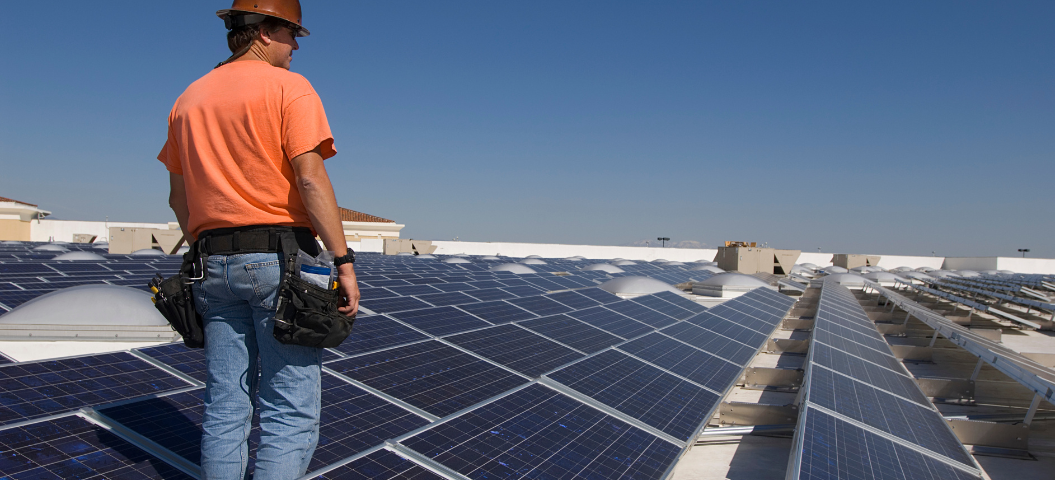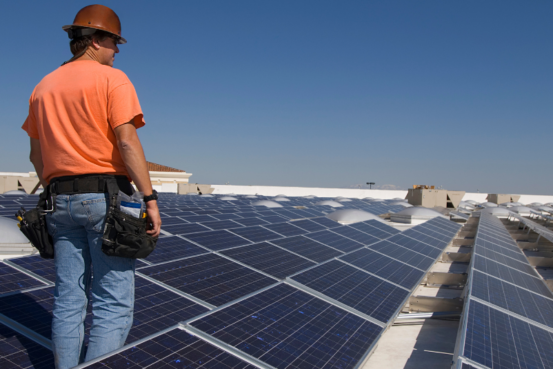A new European Commission proposal for ecodesign and energy labelling rules for photovoltaic panels (PVs) and inverters takes promising steps to make solar energy even cleaner, as panels are set to generate an ever-increasing proportion of Europe’s energy supply. A pioneering carbon footprint threshold for solar panels is also on the cards
Pioneering ecodesign rules could make solar energy even cleaner
A new European Commission proposal for ecodesign and energy labelling rules for photovoltaic panels (PVs) and inverters takes promising steps to make solar energy even cleaner, as panels are set to generate an ever-increasing proportion of Europe’s energy supply. A pioneering carbon footprint threshold for solar panels is also on the cards.
In response to the hardships and global energy market disruption caused by Russia’s invasion of Ukraine, the European Union wants to become less dependent on Russian gas while speeding up the green transition. The REPowerEU plan seeks to increase the share of renewables by 2030. Up from the previous 40% goal, the EU now aims to cover 45% of its energy needs with renewables.
Solar energy will be an important part of the answer. Since 2012, solar generation has been steadily increasing in the EU, reaching 14% of the bloc’s gross electricity consumption in 2020. Based on current market trends, it is estimated that solar has the potential to meet 20% of the EU electricity demand by 2040. This is good news: we urgently need to replace fossil fuel-based energy production. The International Energy Agency (IEA) states that, in a net zero by 2050 scenario, almost 90% of electricity generation will need to come from renewable sources, with wind and solar PV together accounting for nearly 70%.
Ecodesign to power an even brighter future for solar
Solar is one of the most sustainable energy sources we have. But it can become even greener.
While solar panels generate much more energy than is used to manufacture them, their production can have significant environmental impacts. Negative effects include the mining of metals and rare earth minerals, the panel production process (or, more specifically, the emissions from the energy powering this process), and the transportation of raw materials and finished panels.
Currently, it is difficult to compare PV products accurately on issues such as carbon footprint or material use. This should change. The economic viability of solar is ever-increasing, and it will likely take up a larger proportion of Europe’s energy mix down the line. In this scenario, it is imperative that adequate measures are taken to ensure they are produced sustainably and that the end user is aware of the environmental impact of the products they purchase.
The REPowerEU plan mentions ecodesign and energy labelling as the policy framework to tackle the carbon and environmental footprint of solar panels.
It doesn’t come as a surprise. Ecodesign and energy labelling make it easier and cheaper for businesses, citizens and governments to help deliver on the EU’s energy efficiency and the European Green Deal objectives.
Ecodesign sets requirements, which only allow on the market products that meet certain efficiency and environmental thresholds. On the other hand, energy labelling rewards efficient products by grading them higher on the efficiency scale.
Such rules already apply to dozens of appliances and ICT products. Solar panels and inverters were stuck on the waiting list – until now.
A carbon footprint threshold for solar panels
In June 2022, the European Commission presented its proposal for ecodesign and energy labelling requirements for photovoltaic modules, inverters and systems at an expert group meeting.
The Commission proposes to set a carbon threshold on solar panels that will become stricter over time. Manufacturers will have to calculate and report the emissions associated with the production of PV panels and remain under a certain threshold to sell their products in the EU.
This proposal can potentially make solar energy even cleaner, and sets an important precedent in ecodesign – no ecodesign regulation currently covers product carbon footprint.
A carbon threshold would be a pioneering measure. It would have great potential to reduce the carbon intensity of the modules and further improve the environmental credentials of solar energy. The least sustainable PV panels on the market will be filtered out, leaving only more efficient and less impactful products on the market.
The carbon footprint threshold comes at a crucial moment. The European Commission is about to extend ecodesign to virtually all products on the market through the Ecodesign of Sustainable Products Regulation (ESPR). Setting a carbon footprint requirement on solar panels now will help build the necessary experience to expand this measure to more products.
An energy label on a product that generates energy?
The Commission’s proposal includes many more aspects, such as requirements on the availability of spare parts… and the introduction of an energy label for PV modules. The new energy label would rate PV panels according to their relative expected energy yield over their lifetime, displayed by climatic zone.
Adding an energy label to solar panels is tricky. After all, a solar panel is meant to generate energy, not consume it.
We think that an Ecolabel would be a better tool. Granted to the 10% most sustainable modules, the Ecolabel could better capture the environmental impact of solar energy in a way that is not confusing for consumers.
If, despite everything, the EU decides to introduce an energy label on solar panels and inverters, officials should be careful with every detail – and avoid massive consumer confusion. A label should not promote the false idea that solar panels consume more energy than they produce.
EU rules for solar panels coming up in 2023 – if authorities advance at the right pace
Several essential steps await before the European Commission’s proposals become law.
First, the Commission will issue a public consultation open for anyone to react. The methodology for the new elements included, such as the carbon footprint calculation method, will be developed based on the answers received. This is expected to take place during the second quarter of 2023. Then, EU member states will vote on the final proposal.
Given the long process ahead, the Commission and EU governments must advance as swiftly as possible in developing these new rules. The rules proposed by Brussels are set to make of solar panels an even better contributor to the energy transition. With solar panels becoming ever more popular among households, the EU should introduce these rules as soon as possible and avoid unnecessary delays. Authorities have no time to drag their feet.




